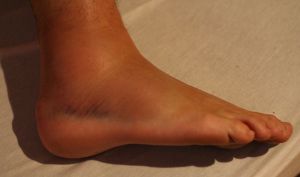
Plantar Cutaneous Feedback & Ankle Instability
Greetings from New York City! This week’s post I wanted to share a topic that is of great interest to me– barefoot training for ankle instability.
Every month I like to check out the newest issues of my favorite exercise science, sports medicine and Podiatry journals. During my reading, I came across an interesting article on the chronic ankle instability and plantar cutaneous feedback.
Chronic Ankle Instability
Ankle sprains are one of the most common injuries in the physically active – and one of the most common foot & ankle related injuries treated in an emergency room setting. It is estimated that up to 70% of individuals who experience an ankle sprain have residual symptoms including instability or recurrent sprains (Hoch 2012). This persistent instability is referred to as chronic ankle instability.
To date, most research has focused on the residual impairment within the proprioceptors of the musculotendinous junction, ligaments and joint capsule. In response to this research, most CAI treatment programs include your standard perineal strengthening, wobble board training and instability training in general.
But does this effectively address the residual instability and risk of re-injury observed in patients and clients suffering with CAI?
Not necessarily!
Role of Plantar Cutaneous Receptors
An important source of somatosensory information in ankle stability is the plantar cutaneous receptors of our feet. Because our feet are the primary interface between the body and the environment, it is only logical that they would play a critical role in upright balance and stability.
An interesting study done in 2002 demonstrated that there was a loss in postural control and gait when the plantar cutaneous foot was anesthetized (Liu 2002). Although completely anesthetizing the bottom of the foot is a bit extreme compared to normal functional cutaneous feedback, it does support the association between the sensory input from the bottom of the foot and postural stability.
The 2012 study by Hoch et al. found that those subjects with CAI not only had impaired proprioceptive feedback at the joint level – but also as it relates to the skin on the bottom of the foot.
Patients with ankle instability had delay in cutaneous response!
Hoch et al. found that he greatest cutaneous impairment in subjects with ankle sprains were between 10 Hz and 50 Hz which correlates with specific plantar mechanoreceptors such as: Ruffini organs (skin stretch), Merkel disks (texture perception), and Meissner corpuscles (light touch).
If plantar cutaneous receptor sensitivity is so significantly impaired in those with CAI, wouldn’t a more effective proprioceptive training integrate stimulation of the plantar cutaneous receptors?
How can you apply this research?
When I get a patient in my office that has either an acute ankle sprain or CAI, it is my goal to integrate the latest in evidence-based treatment programs.
I prescribe barefoot proprioceptive training including:
- ankle taping in non-elastic athletic tape (skin stretch).
- barefoot vibration training (vibration)
- barefoot balance rehab on various textured surfaces including astroturf or indoor carpet (texture)
I want to take advantage of the low Hz mechanoreceptors which will increase the sensitivity of the plantar foot and ultimately speed the reaction time.
You too as a health & fitness professional can apply this research by integrating barefoot proprioceptive training into your client or athlete’s program. Try to avoid foam training modalities as these actually block cutaneous proprioceptive input.
To learn more about the latest research in barefoot training and the Barefoot Training Specialist program please visit us at www.ebfafitness.com
Reference:
Hoch, M. et al. Plantar vibrotactile detection deficits in adults with chronic ankle instability. Med & Science in Sports & Exercise, 2012. 44(4): 666-672.
Liu, W. et al. Noise enhanced vibrotactile sensitivity in older adults, patients with stroke and patients with diabetic neuropathy. Arch Phys Med Rehab, 2002. 83 (2): 171-6.




